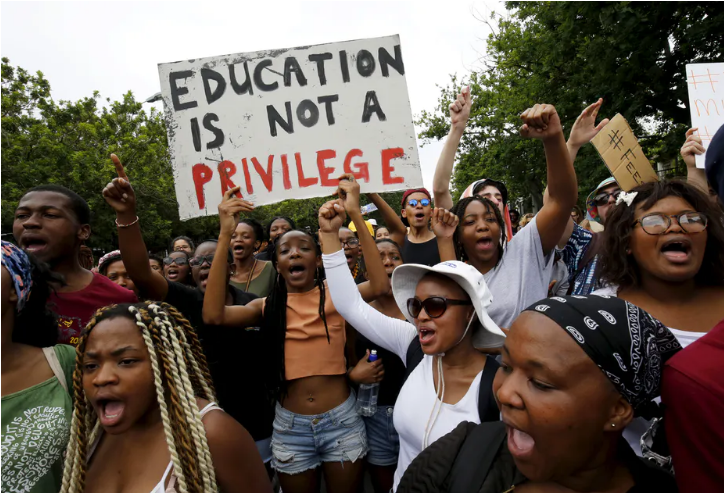Student historic debt to universities has escalated to approximately R14 billion.
Analysts say this has caused a sustainability crisis in our higher education institutions.
Universities South Africa (USAf) said this crisis has been ongoing for decades and that it is now time for a government-led policy process that produces a long-term, sustainable solution.
USAf’s Chief Executive Officer Professor Ahmed Bawa said universities, while being anxious to ensure that students do continue their studies and graduate, are also committed to being financially viable. He added that this is why higher education institutions seek to ensure that the debt levels are minimised.
“Student debt cannot possibly be resolved at the institutional level.
“USAf must signal now, as we did signal in December 2017, that the long-term sustainability of this bursary programme is of deep concern to us,” said Bawa.
He added that the perennial challenge of the further accumulation of student debt accrued by students who fall outside of the National Student Financial Aid Scheme (NSFAS) threshold in family income requires a government-led approach.
Research shows that universities have been experiencing declines in government subsidy on a per capita basis over the last few years. This, together with government’s proposal for the regulation of tuition fee increases, the cuts in funding for research and innovation and the challenges related to student funding conspire to drive growing concerns over the sustainability of the institutions and the sector.
In his presentation to the ANC national executive committee (NEC), the department of higher education, science and innovation minister, Blade Nzimande, recommended even further cuts to university subsidies.
Nzimande was tasked by government to cover the R5.7 billion NSFAS shortfall that had earlier led to the department’s decision to cap first-time university entrants.
The decision led to a nation-wide strike that ended in the death of a bystander shot by police during their clashes with students. The student demands included the write-off of student debt by government and that universities should allow students owing them money to register for the current financial year.
Nzimande said the NSFAS shortage will be paid by R3.09 billion in voted funds previously allocated towards university subsidies and the infrastructure money that was set aside for Technical and Vocational Education and Training (TVET) colleges.
Bawa said: “Year-by-year, these budgetary constraints nibble away at the effectiveness of the higher education system undermining its status as the continent’s strongest one and as one that is globally recognised as being highly productive.”
Nzimande also admitted that his department did not have a plan to fund students referred to as the “missing middle”.
The “missing middle” refers to students who do not meet the NSFAS financial eligibility criteria but still struggle to afford higher education. These students are referred to as the missing middle as many are not able to access higher education due to the inability to source bank loans and other sources of funding.
In his presentation to the ANC NEC, Nzimande said much of the debt at higher education institutions is carried by missing middle students, both current and past students.
“There are different estimates of the numbers of students in this category, as the institutions do not have accurate socio-economic data. The Ministerial Task Team appointed by the Minister in 2016 estimated the figure to be approximately 20% of undergraduate students,” said Nzimande.
In 2016, an approved pilot project was established to test possible funding models, which became the Ikusasa Student Financial Aid Programme (ISFAP), to develop funding and support model for poor and missing middle students.
The original intent of the pilot was to address the feasibility of granting loans/bursaries with progressive reducing subsidies as household income increases for the “missing middle” students
Nzimande said the original modelling assumed that government would cover full or part of the equity required to cover bad debt, but this assumption was not supported by National Treasury.
“A loan -based system would be very difficult without government support. Amongst other reasons, because in all modelling done, the bad debt, capital repayment, and capital interest was always bigger than the repayments and interest paid by the student,” he said.
Adding that the original modelling, ISFAP assumed that government would cover full or part of the equity required to cover bad debt, but this assumption was not supported in interactions with National Treasury,” he said.
Nzimande said The ISFAP model does not provide a universal solution to issues of missing middle funding required.
The work also needs to take into account the substantial changes in the student funding environment since 2018, the student debt issues in the system, and the many other demands on State funding for higher education and training such as postgraduate funding support, as well as the fiscal context. This work will form part of the policy review process to be undertaken by the Department, said Nzimande.
In March, Deputy Higher Education Minister Buti Manamela said: “We cannot have this unsustainable debt situation because universities will basically collapse and so that’s the one thing that will be involving all the stakeholders in coming up with a sustainable solution.”
Former University of Free State vice-Chancellor Professor Jonathan Jansen said it was important that everyone paid back their student debt once they started getting an income so that others could also go to school.
Jansen said historic debt is not something that can “just be erased” and that it required a major re-thinking of the national budget
“What some institutions are doing – letting some register with outstanding debt or extending the registration dates is putting a patch on the sore, that is not solving the problem. We need a systemic resolution of this problem,” he said.
Jansen made the recommendation that government take half of the debt and divide it proportionally to the 26 public universities over the next five years.
“This will immediately assure vice chancellors and their team that they will get that money,” he said.







